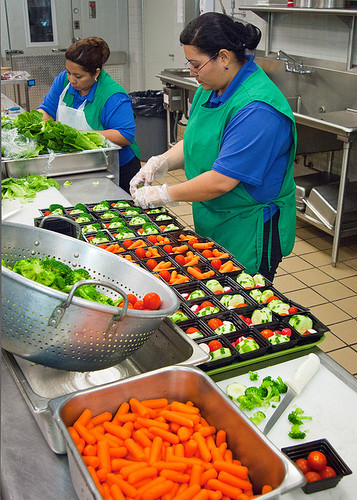
FNS is committed to providing school nutrition professionals with the tools they need to prevent and control norovirus outbreaks.
Can you believe that September is already here? It may not feel like fall where you are, but, slowly, our focus has begun to shift from summer fun to returning to school and learning.
For more than twenty years, September has been recognized as National Food Safety Education Month. The National Food Safety Education Month theme for 2016 is “Notorious Virus.” So what better time to consider learning more about food safety and, in particular, learning more about food safety education in the school environment?
Let’s look first at some basics about norovirus, and then at some tools that child nutrition professionals have available to fight the spread of this highly contagious virus.
Viruses
A virus is a tiny organism that needs a living host to grow. They’re carried by humans and animals, and while they don’t grow in foods or on surfaces, they can be transferred from one host to another by foods, contaminated surfaces or the vomit or feces of an infected person. Viruses are difficult to kill, as they are resistant to heat and cold.
According to the Centers for Disease Control and Prevention (CDC), about 20 million people get sick each year from norovirus, making it one of the leading causes of foodborne illness. It’s most commonly found on ready-to-eat foods and shellfish from contaminated water. And once one person becomes ill, norovirus is easily spread to others. It only takes a small amount of the virus to make a person sick with diarrhea, throwing up and stomach pain.
Norovirus in Schools
The National School Lunch Program operates in about 100,000 public and non‐profit private schools and residential child care institutions and provided more than 5 billion nutritionally balanced lunches each school day in 2015. The School Breakfast Program provided 2.3 billion breakfasts in 2015. The two programs together provide over 7.3 billion meals each school year.
Schools are doing a great job with their food safety efforts!
According to CDC, out of all of the foodborne outbreaks reported to them, less than four percent are associated with schools. Out of that small number, over half of those outbreaks are caused by norovirus. It is important to note that sick food handlers can easily contaminate food and make others sick; effective food safety education programs that focus on foodborne disease prevention are vitally important to successful child nutrition programs.
The USDA Food and Nutrition Service (FNS) is committed to providing school nutrition professionals with the tools they need to prevent and control norovirus outbreaks. A number of educational resources are available from FNS to aid in the fight against norovirus. Throughout September, USDA will highlight norovirus resources on social media, including a fact sheet, an infographic on food safety in schools that focuses on norovirus, a print resource, “The Stomach Bug Book,” and finally, some handwashing resources to help stop the spread of norovirus. Be sure to follow us onTwitter.com/USDANutrition so you don’t miss out.
So, enjoy National Food Safety Education Month, and remember to wash your hands! It’s the best way to prevent the spread of foodborne illness, including norovirus.
No comments:
Post a Comment
Note: Only a member of this blog may post a comment.